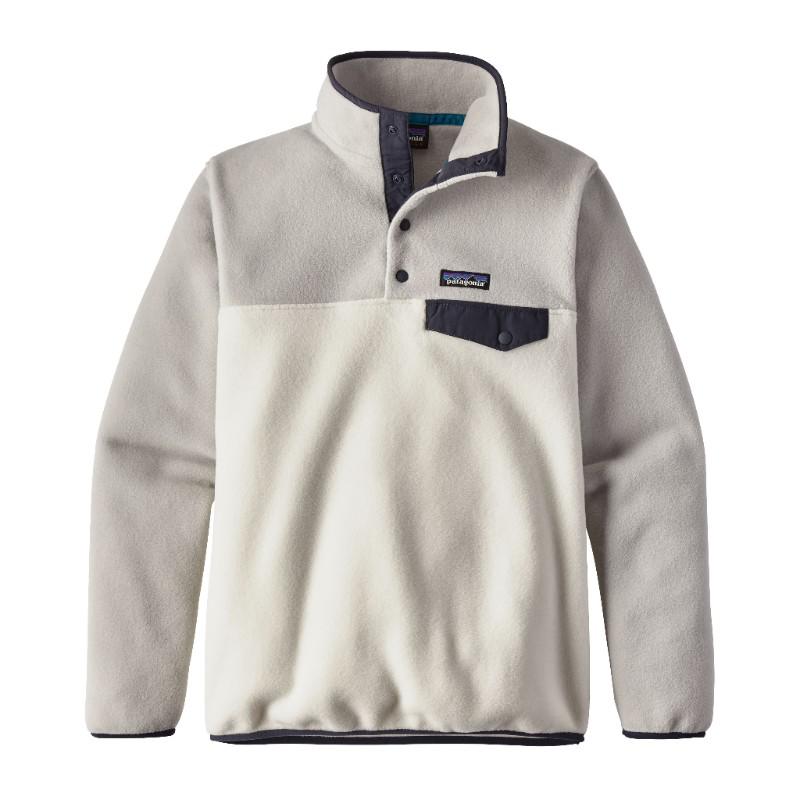Patagonia: this is not a fleece
It's the fleece of the 1980s with a capital P. A creation of the American brand Patagonia, dating from 1985, cut in Synchilla, a double-sided water-repellent fabric that does not pill, lighter and dries faster than wool. Called Snap-T, it can be recognized by its funnel neck with press studs, its acid colors and its flap pocket. At the time, it was in every wardrobe in every American home (we had to wait until 1994 for its marketing in France). Fathers wear it for the Sunday barbecue, mothers over their aerobics leotards, teenagers wear it to ride their BMX or seduce the girls in the halls of high school. Illico, fans of climbing and sliding sports make it their all-terrain uniform. But at the end of the 1990s, like the cropped trousers and the banana, fleece was wiped off the cool map. The trend is towards minimalism, grunge, no more Aztec patterns and vitamin sweatshirts. Shapeless, styleless, in dubious taste, it exposes the wearer to the fiercest mockery.
However, thirty-five years later, the Snap-T offers a second youth, on both sides of the Atlantic. If its nostalgic look resonates today, it is above all the values it represents that set it up as the standard of a generation. “When you buy a Snap-T, you buy a style and affirm your personality, explains Aymeric de Rorthays, general manager of Vieux Campeur, a French partner from the start who helped Patagonia establish itself in France. It's the iconic product that claims your adherence to Patagonia's values."

Yvon Chouinard, the example to follow
Because the comeback of this jacket is very much due to its label. Founded in 1973 by mountaineer Yvon Chouinard, Patagonia is an example in our society, which is aware of sustainable development and global warming. A pioneer, it has used, for example, only organic cotton since 1996; has always donated 10% of its profits to organizations working to save the planet; sends its teams across the United States to repair its used clothes; uses a maximum of recycled fibers (the Snap-T has been made from soda bottles since 1991); thinks of durable and timeless products; invests in innovation. Above all, it refuses to be considered a fashion brand since by definition, fashion… goes out of style.
The company also pioneered flashy shades in the outdoor world - the first piece of clothing offered by Yvon Chouinard, in the 1970s, was a rugby jersey made in Britain by Umbro and in which he climbs with bare hands on the rocky peaks of the great American West, influencing a whole generation of mountaineers. “Patagonia is more than a committed brand, deciphers Éric Briones, co-author of the book Le Choc Z (Éd. Dunod). She is an activist brand. She speaks to the younger generations who are campaigning against overconsumption. Fashion is a political tool, clothing is a short ballot. Wearing this fleece means displaying your convictions, your beliefs, your party, especially since Trump's election. But the return of the Snap-T, it also owes it to its design, its aesthetics. If in the 2010s, it was trendy to associate luxury with fast fashion, nowadays, we associate it with the outdoors.” This is the current Gorpcore - baptized thus by the New York Times in 2017 for Gorp (Good old raisins and peanuts), the classic nutritious snack for hikers - adopted by urbanites wishing to show their love of nature and outdoor sports. .
The "Midtown Uniform"
Ironically, the sudden revival of this jacket came, in part, from Wall Street and the financial young guns who, since the 2008 crisis, paraded the streets of New York in their sleeveless version. A bad ad for Patagonia which, unable to prevent this public from buying it, terminated last April the co-branding contracts authorizing companies and banks to flock their logo on the famous fleece which has become the “Midtown uniform”. More “acceptable” for the brand, its Silicon Valley clientele. “California startuppers have brought a formal wardrobe up to date,” continues Frédéric Godart, sociologist and professor at Insead. There was the hoodie, the Steve Jobs dad sneakers, the shapeless jeans and now the fleece. These tech kids accompanied a technological revolution and found themselves catapulted to the head of the world but not socialized in the culture of luxury. They only wanted this jacket to be a comfortable windbreaker in the valley breeze.”
Unsurprisingly, the Snap-T but also the Retro-X Fleece (identical reissue of the first Patagonia fleece) are the subject of numerous copies on the ready-to-wear catwalks and among outdoor competitors. in recent seasons. This media overexposure (Virgil Abloh does not hide his admiration for Yvon Chouinard, Supreme would have tried a collaboration…) tends to irritate the fans of the first hour. "At Le Vieux Campeur, our customers don't dare ask questions about Patagonia for fear of being seen as followers," laughs Aymeric de Rorthays. However, the success is there, and is not about to disappear. The selective list of points of sale and the refusal of brand sales whet people's appetites. If now, it is less at the forefront of technicality when many competitors are more efficient and eco-friendly, it remains a model. We can't accuse her of surfing the wave of sustainability, she is the initiator of this movement. Patagonia has become a standard.”
SERVICES: Discover all the personalized items at low prices on Etsy









